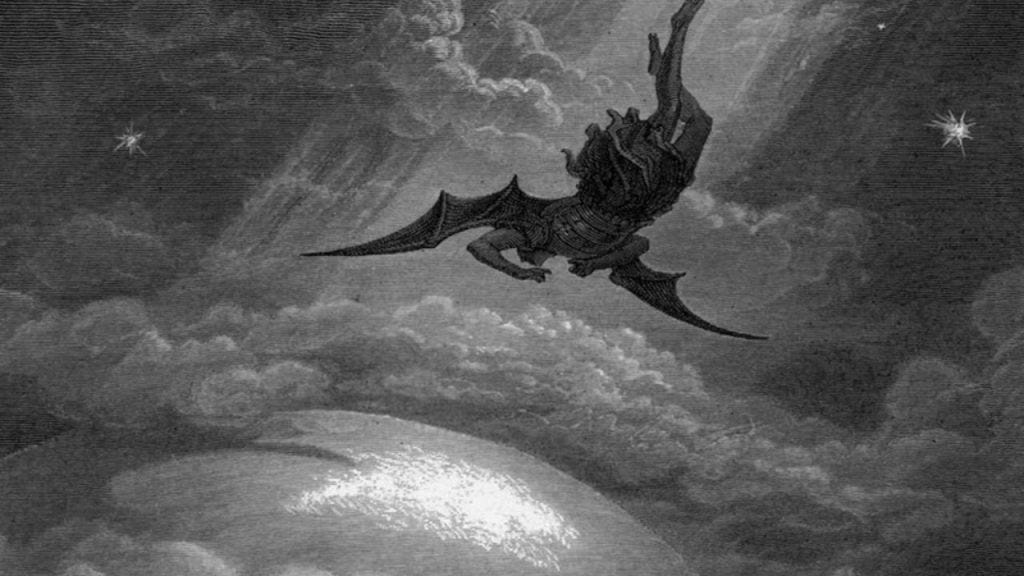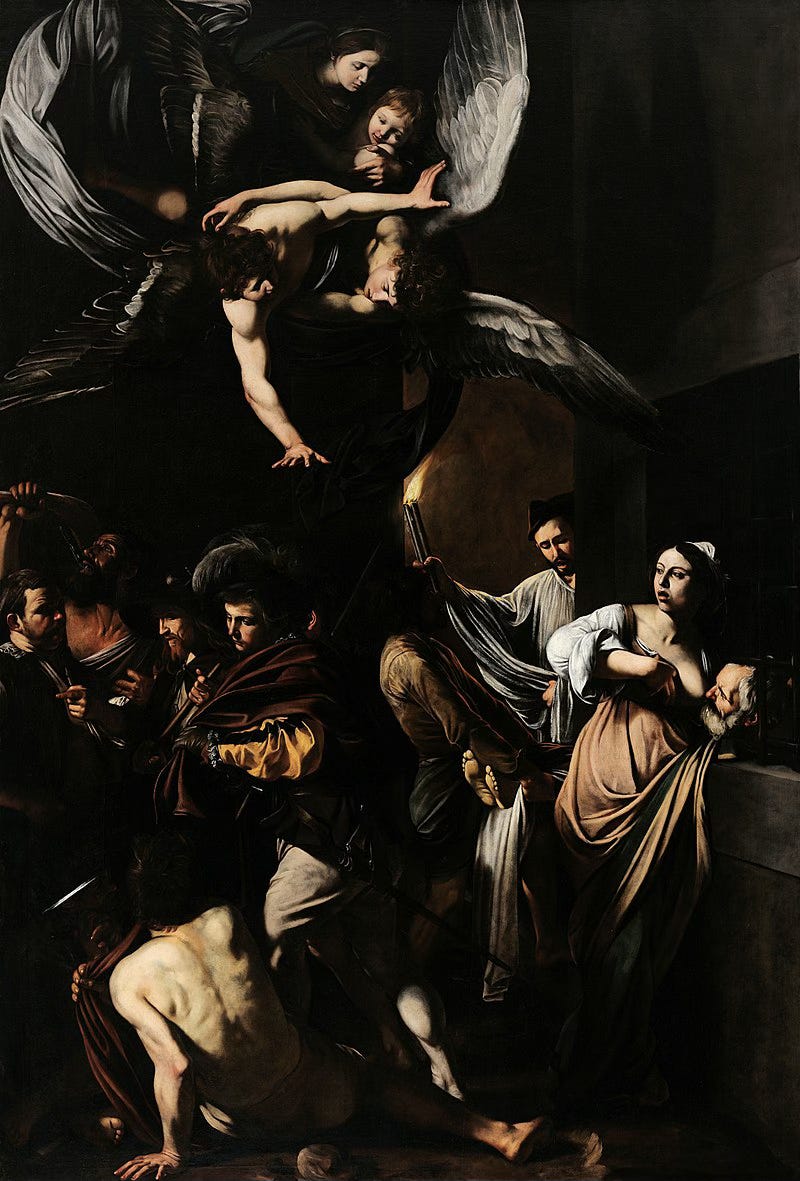The Christian Revolution & Apocalypse: Girard's Eschatological Perspective
Christianity's concern for the victim, modernity, and the spirit of the Antichrist
This is the second talk I gave to the Stanford Girard Society for their 2025 intellectual retreat. You can find the first one, an overview of Girard’s mimetic theory and how Christianity relates to it in I See Satan Fall Like Lightning directly below here:
I See Satan Fall Like Lightning: An Introduction to René Girard's Mimetic Theory
What follows below is the introductory talk I recently gave to the Stanford Girard Society at their 2025 retreat. This is meant as an introduction to René Girard’s mimetic theory and its anthropological application to Christianity. We spent significant time after the talk reviewing the core text for the retreat, Girard’s
Earlier we discussed the fundamentals of Girard’s mimetic theory, the process by which desire drives individuals and then communities to scandal, conflict, and, eventually resolution through violent scapegoating. This process, remember, while pre-rational and unconscious, is fundamental to every society, according to Girard.
We also discussed Girard’s analysis of Christianity and its inversion of this process. Under the scapegoating mechanisms of archaic religions, victims are imagined to be really guilty and are then mythologically deified. In the Judeo-Christian tradition, the victims are shown to be really innocent, and, in the Christian tradition, the victim qua victims, Jesus of Nazareth, is actually God Himself.
As noted earlier, this dismantles the efficacy of the scapegoating mechanism.1 While we may look at the scapegoating mechanism as cruel, evil, or even bizarre, to do so is to look at it anachronistically. To those caught in a mimetic frenzy, this process, though, again, unconscious, is the glue that holds their societies together. Without the scapegoating mechanisms, archaic societies would come apart at the seams as rivalry drives more conformity and conflict, with no obvious way to introduce new opportunities for differentiation.
The perceived guilt of the victims of gone. The veil has been lifted and the crowd is shown to simply be murderers. The old gods are really dead. Christ is risen. But mimesis remains.
This, to Girard, is the opportunity and challenge of Christianity. Christianity simultaneously provides the answer to the conflict at the core of human society and sets us up for the final conflagration, our ultimate destruction.
In this short(er) talk, I’ll cover a few key points:
Christianity’s Answer
Christianity’s effect on the temporal order
Ultra-Christianity, or Christianity without Christ
The Girardian Antichrist
The Apocalypse
Christianity’s Answer
The answer to the question of, “what should we do if mimetic desire remains but our mechanisms of resolving its conflicts are now gone?” is actually given to us not first by Girard, but by Christ Himself and later St. Paul:
Take my yoke upon you, and learn from me; for I am gentle and humble in heart, and you will find rest for your souls. For my yoke is easy, and my burden is light. (Matthew 11:29-30)
Be imitators of me, as I am of Christ. (1 Corinthians 11:1)
This is not some kind of throwaway comment, according to Girard, but is rather the core of the Pauline teaching built on top of the Gospel’s Triumph of the Cross.
In his 2009 essay “On War and Apocalypse,” Girard summarizes up the lesson well. It’s worth quoting at length:
A scapegoat remains effective as long as we believe in its guilt. Having a scapegoat means not knowing that we have one. Learning that we have a scapegoat is to lose it forever and to expose ourselves to mimetic conflicts with no possible resolution. This is the implacable law of the trend to extremes. The protective system of scapegoats is finally destroyed by the Crucifixion narratives as they reveal Jesus’ innocence and, little by little, that of all analogous victims. The process of education away from violent sacrifice thus got underway, but it moved very slowly, making advances that were almost always unconscious. It is only today that it has had increasingly remarkable results in terms of our comfort—and at the same time proved ever more dangerous for the future of life on Earth. To make the revelation wholly good and not threatening at all, humans have only to adopt the behavior recommended by Christ: Abstain completely from retaliation and renounce the trend to extremes.
Recall that in any triangle of desire, the person being imitated is a model. That model is either an internal model or an external model, depending on its distance to the party imitating them. Internal models are near to the person and the rivalry is dangerous.2 These are often the models of archaic religions and founding murder myths – Romulus and Remus, Cain and Abel, Joseph and his brothers, for example. External models are further from the person and the good being desired is, therefore, also less-near. To our modern minds, we might think of role models in celebrities or historical figures.
But according to Girard, Christ fills this role for the Christian. His hypostatic union helps us understand this. He is fully God, so at a great distance from us. And He is fully man, so near enough to us that we can, realistically, strive to imitate him.
Even more, since He is aware of the true nature of desire, Christ can guide us by both inviting desire and desiring non-rivalrous goods. We can, in the words of St. Paul, “run to win the race” and not fear the conflagration of mimetic violence when winning the race means coming into the Love of God and participating in the divinity of Christ.
Girard, again in his essay on Clausewitz, notes:
It is understandable that Christ frightened the apostles [as He is God]. He is also, however, the only model, the one that places man at just the right distance from the divine [as He is also man]. Christ came to reveal that his kingdom was not of this world but that humans, once they have understood the mechanisms of their own violence, can have an accurate intuition of what is beyond it. We can all participate in the divinity of Christ so long as we renounce our own violence.
So, the answer to the question of how do we keep mimetic violence from destroying society if we no longer can rely on the Scapegoating mechanism? Conversion. It is only through the rejection of violence, the imitation of Christ, caring for those who would have been scapegoated in a truly Christian way, that we can dismantle the power of mimetic desire over society.
The Christian Temporal Order: Concern for Victims
The more Christian a society is, the more it recognizes this. It not only rejects the scapegoating mechanism but it incorporates a concern for those victims, victims seen in the personage of Christ, ala His own commands to the corporal works of mercy (see Matthew 25:31-46): ‘Amen, I say to you, whatever you did for one of these least brothers of mine, you did for me.’
To Girard, peak Christianity is probably around the introduction of the modern hospital in the late Middle Ages, an institution which lives out the corporal virtues and charity so blindly that it would have seemed incomprehensible to pre-archaic societies.3 Christianity, by destroying the constraints of the pre-archaic order, is the fertile ground for advances in science and technology, culture and the arts. Again, Girard in 2009:
Freed of sacrificial constraints, the human mind invented science, technology, and all the best and worst of culture. Our civilization is the most creative and powerful ever known, but also the most fragile and threatened because it no longer has the safety rails of archaic religion. Without sacrifice in the broad sense, it could destroy itself if it does not take care, which clearly it is not doing.
Societies that haven’t fully incorporated the Christian message still fall victim to mimetic frenzies, whether it’s witch hunts of the early Reformation period, the people’s crusade of the 11th Century, or lynch mobs throughout American history. These are dangerous, of course, but can be mitigated through further conversion, which is possible in a sacralized order.
Ultra-Christianity and Modernity
For Girard, a society that has de-converted from Christianity is far more dangerous than one that never converted at all. What we call “post-Christian” modernity, Girard sees not as a departure from Christianity but as its hyper-extension. 4
Modernity is a secularized form of Christianity that intensifies Christian concern for victims while severing it from forgiveness, transcendence, and truth. Secular rationalism, then, is not a clean break from Christianity, but a kind of Christianity lived out to the extreme. We can think of it as Christianity without Christ.
Christianity without Christ, of course, means that the solution to mimetic contagion – sincere conversion and true imitation of Christ and the Communion of Saints – is now off-limits. Concern for the victim as the ultimate social value remains, but incorporation of that victim into the suffering of Christ is gone.
So Ultra-Christianity is a social order that values concern for the victim and still has the threat of mimetic contagion, but is now left without either the pre-archaic religions and rites of sacrifice to prevent destruction or Christian conversion to prevent destruction. Instead, you get cycles of mimetic violence driven by a desire to save the victim but without the call to conversion and forgiveness. Rivalry erupts out of a desire to save the victim. Mimetic violence is back and now draped in the moral language of Christianity. Think here of how every political conflict in ultra-Christian society is framed in terms of who can better save the victim. Ironically, this means creating scapegoats out of those engaged in scapegoating.
In short, there is nothing holding back mimetic violence any longer. This holding back is described by St. Paul as the katechon:
“And you know what is restraining [τὸ κατέχον] him now so that he may be revealed in his time… the mystery of lawlessness is already at work; only he who now restrains it will do so until he is out of the way.” (2 Thess. 2:6–7).
This katechon for Girard is not only a theological concept. It is whatever holds back mimetic violence (and, ultimately, the Apocalypse)5: forgiveness and conversion in Christian theology but even ritual sacrifice or legal structures in an anthropological lens. The collapse of the katechon is the collapse of structures, whether legal, social, or theological, that hold back “the mystery of lawlessness.”
The Spirit of the Antichrist
This, for Girard, brings us to the spirit of the Antichrist: mimicking Christ’s mission while denying the core of His message. This is why Girard says the Antichrist “boasts of bringing to human beings the peace and tolerance that Christianity promised but has failed to deliver.”6
I want you to imagine Luca Signorelli’s painting The Preaching of the Antichrist to get this picture in your mind. A large renaissance painting with many of the usual characters, you see in the center of the painting a man who looks like Christ. Whispering in his ear is Satan, and through the purple cloak the Antichrist is wearing, Satan has slipped his hand, so the Antichrist’s hand is, really, Satan himself. The Antichrist, to Girard, is a counterfeit of Christ, not his complete inversion.
This counterfeit uses the Christian message of concern for the victims (now dressed up in the language of Western humanism that nations from the United States to the EU to even China and Saudi Arabia use) but whips us further into mimetic violence with this message. Social discord rises over who can express more concern for victim groups, children are dismembered in the womb under the pretense of protecting victims, entire generations are cleansed in corporate eugenics of embryo selection to avoid having more “victims,” wars are waged over “protecting victims,” armament factories are built and funded and technological arms races accelerate to protect hypothetical victims. This is the spirit of the Antichrist – mimicking as Christ without His message of renunciation of violence, using violence for the ends of concern for the victim.
Apocalypse
So we’re in a place with no katechon, mimetic violence that wears the skin of Christianity by giving lip-service to concern for victims but rejecting conversion, and the potential to destroy the world in a way that was before totally technologically infeasible. It’s almost a throwaway line towards the end of I See Satan Fall Like Lightning, but Girard thought this was the groundwork for the apocalypse. Without conversion – true, deep conversion that involves imitating Christ’s desires and rejecting the violence that brings mimetic conflagrations to the fore – we risk destroying not just ourselves, but the world entirely.
Towards the end of his life, he seemed particularly concerned about radical Islam, as evidenced in the 2009 essay from which I’ve repeatedly quoted. Islamic terrorism uses what looks like a pre-archaic religion but comes at a time when the world is so ultra-Christian that we’ve totally lost any kind of mechanisms for responding to the threat of radical Islam. We lack the Christianity to convert radical Islamists. But our concern for the victim allows us to barrel towards a violent and technological conflict with this pre-archaic force.
That was sixteen years ago. I have to wonder how Girard’s analysis would change today. Radical Islam still exists, of course, but now we have new Satanic forces accelerating in our world. Videos of great human atrocities can be pumped into the phone of every man, woman, and child around the world within a day. Social media creates the illusion that external mediators are really more like internal mediators, whipping up mimetic conflict at a higher and faster pace. Concerns about a new artificial intelligence arms race – and a literal arms race over protecting countries with the capital for artificial intelligence – seed more opportunities for technologically-rich mimetic conflict.
I suspect his solution would be the same: radical conversion to Christ. Conversion, remember, is a turning away. We have to turn away from the rivalry and scandal that drives us towards mimetic conflagration, not merely not-engage.
In a world consumed by rivalry, scandal, and self-righteous victimhood, only the imitation of Christ — loving enemies, refusing retaliation, embracing the Cross — can break the cycle.
Everything else will fail. Everything else already is failing.
Remember your leaders, those who spoke the word of God to you; consider the outcome of their way of life, and imitate their faith. Jesus Christ is the same yesterday and today and forever. Do not be carried away by all kinds of strange teachings…
Hebrews 13:7-9a, from Lauds for the memorial of St. Philip Neri
I See Satan Fall Like Lightning, Girard, Orbis Books, p. 138, “The Crucifixion reduces mythology to powerlessness by exposing violent contagion, which is so effective in the myths that it prevents communities from ever finding out the truth, namely, the innocence of their victims.” and p. 139, “When the single victim mechanism is correctly nailed to the Cross, its ultimately banal, insignificant basis appears in broad daylight, and everything based on it gradually loses its prestige, grows more and ore feeble, and finally disappears.”
(Added June 11, 2025) - Girard actually believes that Christianity brings all mediation into being internal mediation, and sets the scene for ultra-Christianity through destroying external mediation. He identifies “end of external mediation in the 16th and 17th century.” He notes this in his work, “Innovation and Repetition” in 1990, though doesn’t make this point explicit in I See Satan Fall Like Lightning. Thanks to Jeremy Welch for the correction, as this is helpful in filling the gap between Christianity and ultra-Christianity.
ibid. p. 167
ibid. chapter 13, “The Modern Concern for Victims”
ibid. p. 186
ibid. p. 181






